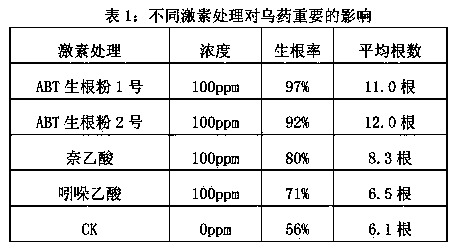Sustainable three-nerved spicebush cultivation method
A cultivation method and technology of black medicine, applied in the field of cultivation, can solve the problems of environmental damage, waste of resources, etc., and achieve the effects of preventing infestation and damage, protecting the environment and shortening the growth cycle.
- Summary
- Abstract
- Description
- Claims
- Application Information
AI Technical Summary
Problems solved by technology
Method used
Image
Examples
Embodiment 1
[0024] The method for sustainable cultivation of black herbal medicine in this embodiment includes the following steps.
[0025] (1) Choose a three-year-old wild black herb with a ground diameter of about 0.5 cm, and cut off 2 / 3 of the branches above the ground in April in spring.
[0026] (2) Dig out the soil at the root of the pruned black herb, lift the whole plant, and cut off the enlarged root tuber with scissors. The cut tuber is about 3.7 grams.
[0027] (3) Trim all the roots of black herb to a length of 5cm.
[0028] (4) Soak the root pruning wound in 1% calcium hydroxide aqueous solution by mass for 5 seconds, take it out and dry it, and pay attention that the calcium hydroxide aqueous solution should not overflow the wound for more than 5mm when the wound is soaked.
[0029] (5) Mix the excavated soil with 0.1% ABT1 root powder by mass percentage and 1% Trichodia granulosus fermentation broth.
[0030] (6) Replant the agarica plants treated in step (4) back into t...
Embodiment 2
[0035] The method for sustainable cultivation of black herbal medicine in this embodiment includes the following steps.
[0036] (1) In a pine-broad mixed forest with a canopy density of 0.6, 100 6-year-old agraria agraria were selected for biomimetic cultivation, with a ground diameter of about 1.0 cm, and 2 / 3 of the above-ground branches were cut off in April in spring.
[0037] (2) Dig out the soil at the root of the pruned black herb, lift the whole plant, and use scissors to cut off the swollen root tuber at the root. The tuber cut from each plant is about 31.1±3.7 grams.
[0038] (3) Trim all the roots of black herb to a length of 10cm.
[0039] (4) Soak the root pruning wound in 1% calcium hydroxide aqueous solution by mass for 5 seconds, take it out and dry it, and pay attention that the calcium hydroxide aqueous solution should not overflow the wound for more than 5mm when the wound is soaked.
[0040] (5) Mix the excavated soil with 0.1% ABT1 root powder by mass per...
Embodiment 3
[0046] The method for sustainable cultivation of black herbal medicine in this embodiment includes the following steps.
[0047] (1) Choose a wild or cultivated black herb plant that is more than three years old, and cut off two-thirds of the branches above the ground in spring or autumn to obtain the pruned black herb.
[0048] (2) Dig out the soil at the root of the pruned black medicine, lift the whole plant of the pruned black medicine, and use scissors to cut off the enlarged tuber at the root of the pruned black medicine.
[0049] (3) Prune all the roots of the pruned black herb to a length of 8-12 times the ground diameter.
[0050] (4) Soak the pruned wound of the root of the pruned black medicine in 1% calcium hydroxide aqueous solution for 5 seconds, take it out and dry it. When the wound is soaked, the liquid surface of the calcium hydroxide aqueous solution overflows the wound , and the distance between the liquid surface and the wound is less than 5mm.
[0051] ...
PUM
 Login to View More
Login to View More Abstract
Description
Claims
Application Information
 Login to View More
Login to View More - R&D
- Intellectual Property
- Life Sciences
- Materials
- Tech Scout
- Unparalleled Data Quality
- Higher Quality Content
- 60% Fewer Hallucinations
Browse by: Latest US Patents, China's latest patents, Technical Efficacy Thesaurus, Application Domain, Technology Topic, Popular Technical Reports.
© 2025 PatSnap. All rights reserved.Legal|Privacy policy|Modern Slavery Act Transparency Statement|Sitemap|About US| Contact US: help@patsnap.com



